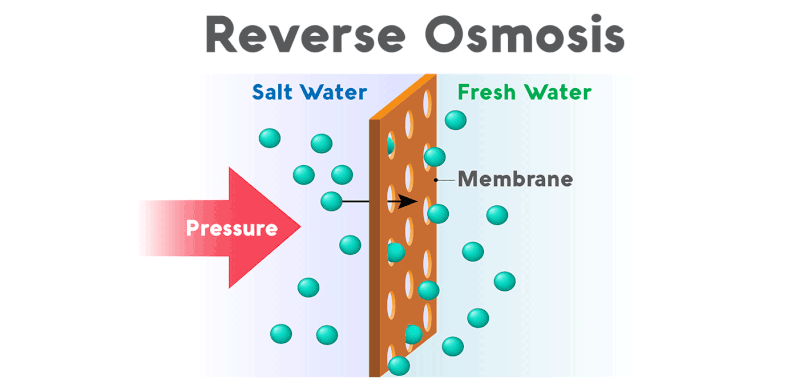Selecting the correct water filtration technology is essential to get the purified water without wasting extra resources and money on technologies that are not required.
Reverse Osmosis and Nanofiltration are two advanced water filtration technologies widely available in the market. RO is an all-in-one solution for water filtration when the TDS level is very high.
Installing an RO where the water TDS level is already less than 300 is a waste of money as Nanofiltration is enough to do the job for you.
In this article, we will learn more about these technologies and find the differences between Nanofiltration Vs Reverse Osmosis.
What is Nanofiltration?
Nanofiltration is a membrane filtration process that falls between reverse osmosis and ultrafiltration. It is designed to remove a wide range of molecules from the water, including divalent ions and large organic molecules.

How nanofiltration works
Nanofiltration works by using a semi-permeable membrane with very small pores, typically ranging from 1 to 10 nanometers in size. When water is forced through the membrane, the smaller particles and ions can pass through, while the larger molecules and ions are retained. This process effectively removes unwanted substances from the water, leaving it clean and purified.
Applications of nanofiltration
Nanofiltration is commonly used for water softening, color removal, and the removal of specific ions such as nitrate, sulfate, and fluoride. It is also used in the food and beverage industry for the concentration and fractionation of components such as lactose and protein.
What is Reverse Osmosis?
Reverse osmosis is a water purification process that uses a partially permeable membrane to remove ions, molecules, and larger particles from drinking water. It is a highly effective method for producing clean and pure water.

How reverse osmosis works
Reverse osmosis works by applying pressure to the water, forcing it through a semi-permeable membrane. The membrane has very small pores, typically around 0.0001 microns in size, which can effectively remove contaminants such as salts, bacteria, and other impurities from the water. The result is clean, purified water that is suitable for drinking and other applications.
Applications of reverse osmosis
Reverse osmosis is widely used for desalination of seawater, production of drinking water, and treatment of wastewater. It is also used in the pharmaceutical and food industries for the production of purified water for various processes.
Nanofiltration Vs Reverse osmosis: What’s The Difference?

Pore size and filtration level
The main difference between nanofiltration and reverse osmosis lies in the size of the pores in the membrane. Nanofiltration membranes have larger pores compared to reverse osmosis membranes, allowing for the passage of certain ions and molecules that would be rejected by reverse osmosis.
Energy consumption
Nanofiltration generally requires less energy compared to reverse osmosis, as it operates at lower pressures and allows for the passage of some ions and molecules through the membrane.
Rejection of contaminants
Reverse osmosis is more effective at rejecting a wider range of contaminants, including salts, bacteria, and viruses, compared to nanofiltration. This makes reverse osmosis the preferred method for producing highly purified water.
Water pressure requirements
Reverse osmosis typically requires higher water pressure to operate effectively, while nanofiltration can operate at lower pressures due to its larger membrane pores.
Pros and Cons of Nanofiltration
Advantages of nanofiltration
- Lower energy consumption
- Ability to selectively remove specific ions and molecules
- Lower operating pressure requirements
Disadvantages of nanofiltration
- Less effective at removing a wide range of contaminants compared to reverse osmosis
- Limited applications for producing highly purified water
Pros and Cons of Reverse Osmosis
Advantages of reverse osmosis
- Highly effective at removing a wide range of contaminants
- Suitable for producing highly purified water for drinking and industrial use
Disadvantages of reverse osmosis
- Higher energy consumption
- Higher operating pressure requirements
- Removes beneficial minerals along with contaminants
Conclusion: Nanofiltration Vs Reverse osmosis
In conclusion, both nanofiltration and reverse osmosis are effective methods for purifying water, each with its own set of advantages and disadvantages. The choice between the two depends on the specific requirements of the application, such as the level of purity needed and the energy and pressure constraints.